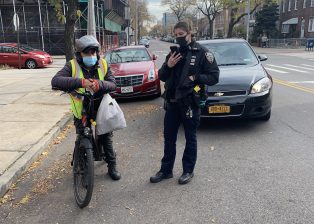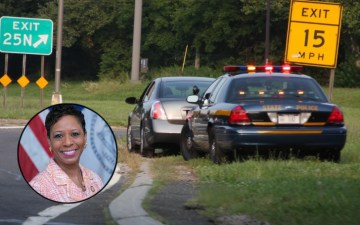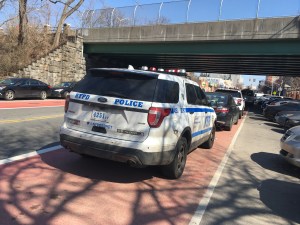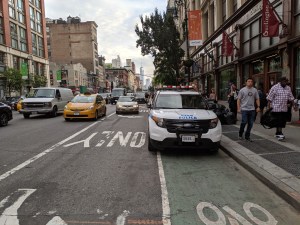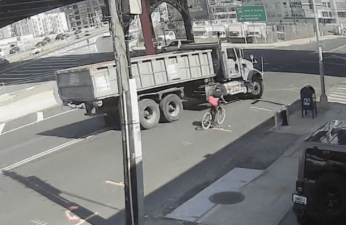Campaign To Remove NYPD From Traffic Enforcement Picks Up Endorsement From State’s Top Prosecutor
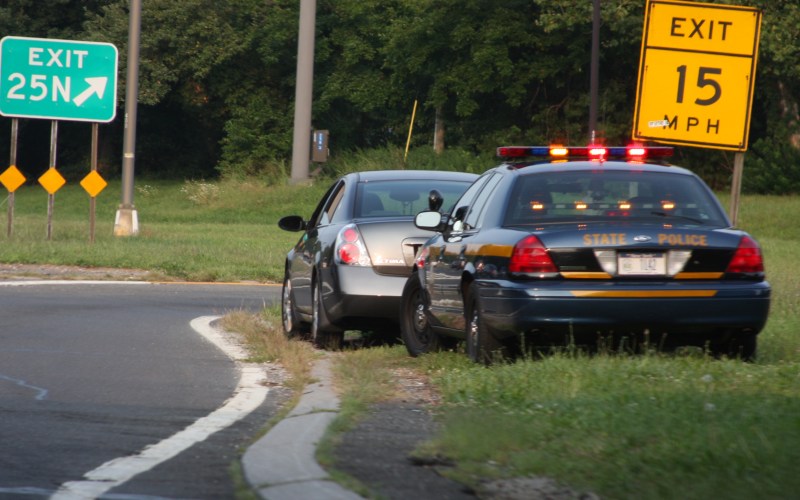
New York State’s top prosecutor last month endorsed a plan to get the NYPD out of traffic enforcement, giving more momentum to a growing campaign that advocates say will not only make streets safer from crashes, but will also protect Black and Brown New Yorkers, who are disproportionately victims of police brutality.
Attorney General Letitia James unveiled a report on Sept. 25 recommending that police cease conducting traffic stops, following her investigation into the fatal shooting of Allan Feliz, whom cops killed during a so-called routine traffic stop in the Bronx last year.
“We recommend that the city remove NYPD from engaging in routine traffic enforcement,” James wrote in her 37-page report. “We were gravely concerned by some of the actions of the responding officers and issued a number of recommendations that the NYPD should take into account, including removing officers from engaging in any type of routine traffic enforcement activity.”
James is now the highest ranking state-wide elected official to call for getting the NYPD out of traffic enforcement, though she fell short of demanding that they are entirely removed from the practice. Instead, bowing to political reality, James put out five recommendations for cops to follow when conducting traffic stops:
- Officers conducting a car stop should ensure that the vehicle can’t be moved throughout the encounter,
- During a car stop, officers should consider checking the motorist’s license and registration at a safe distance from the vehicle,
- During a car stop, an officer should not enter a vehicle over which the motorist has dominion and control,
- NYPD should modify its must-arrest policy for warrants for failing to appear on a summons, and for bench warrants on violations discovered during a car stop,
- All officers should be follow proper car stop protocols as set forth in the NYPD Vehicle Stop Manual.
“We believe that, going forward, the adoption of these recommendations would significantly limit the likelihood of the kind of escalation that resulted in Mr. Feliz’s death,” James wrote in her report.
James, who was previously the city’s Public Advocate and a Brooklyn Council Member, says she was forced to act after police escalated a traffic stop — which itself raised questions — and killed Feliz on Oct. 17, 2019.
The incident began as many do: police had pulled over Feliz because he allegedly wasn’t wearing a seatbelt — a minor violation that advocates say cops irregularly enforce, disproportionately targeting people of color.
Feliz handed cops a driver’s license that actually belonged to his brother — who had three open warrants for minor offenses. Those warrants quickly popped up when police ran the license, prompting cops to ask Feliz to get out of the car so they could pat him down. Feliz complied, but then jumped back in when the officer, Police Officer Edward Barrett, briefly turned towards his partner, Sgt. Jonathan Rivera.
Barrett believed Feliz was attempting to drive away and started punching and grabbing him, while other officers immobilized Feliz with an electric shock device. After the stunning, Feliz again tried to drive away, cops say. That’s when Rivera climbed into the car with the intention of pushing Feliz out.
Feliz continued to put the car into drive, and jerked it forward several times, while Barrett was still on the passenger side. Rivera used the electro-shock device again on Feliz, and threatened to shoot him if he did not comply with the orders. Both Rivera and Barrett said they believed that if Feliz drove away, the car would drag Barrett under it, putting his life at risk.
Finally, Rivera fired one shot into Feliz’s chest, killing him. Neither officer was reprimanded, and Feliz’s family filed a $350-million civil lawsuit against the NYPD in June. James’s office determined that the officers could not be held criminally responsible.
But what happened to Feliz is tragically not a unique case — cops are 40 percent more likely to stop a Black driver than a white driver, studies show, many of which have led to police brutality and death.
In 2015, 28-year-old Sandra Bland suspiciously died after police arrested her during a traffic stop that began after she allegedly failed to signal a lane change in Texas in 2015; in 2013 in New York City, 23-year-old Sean Bell was shot and killed by police who fired 50 shots at a car Bell and his friends were in; this past May, 28-year-old Maurice Gordon was shot and killed by a state trooper in New Jersey during a traffic stop; and in 2016, 32-year-old Philando Castile was shot and killed by a cop during a traffic stop in Minnesota.
Advocates say the list of people killed by police during traffic stops is already one name too long, and will only grow if police continue to arbitrarily enforce traffic laws using their own discretion — a practice that does nothing to make streets safer for anyone, while only putting more Black and brown motorists at risk.
Instead of having cops pull people over for going above the speed limit or driving without a speed belt, the city and state should invest in more automated cameras to catch speedsters and scofflaws, and actually redesign roads to make it physically harder to speed, said Marco Conner DiAquoi of Transportation Alternatives, which similarly put out a report this summer calling for the de Blasio administration to remove the NYPD from traffic enforcement.
“If you invest in safe streets, put roads on road diets, it automatically slow drivers down,” he said. “That gap should be filled with automated enforcement, investing in speed-, red-light, bus lane enforcement cameras. That is very effective in discouraging dangerous driving, and on top of that, it completely avoids the risk of excessive use of force.”
After James’s recommendation, a new report from Data Progress also revealed that New Yorkers overwhelmingly support the idea to boot cops from traffic enforcement — 54 percent of likely voters in New York say they would support replacing police who engage in traffic enforcement with a new non-police, non-weaponized Traffic Safety Service within the state’s Department of Transportation. And in New York City, a whopping 70 percent of likely voters say they would support the idea, according to the report by State Senator Alessandra Biaggi, who represents portions of the Bronx.
“Traffic stops are viewed as an essential tool in the law enforcement arsenal because officers are constitutionally permitted to search a vehicle during a stop if there is probable cause to believe evidence of a crime exists in the vehicle or if it is reasonably necessary for officer safety. But so often the probable cause appears to be driving while Black,” said Biaggi. “The traffic stop frequently serves as pretext for significantly more invasive crime enforcement and is used to permit the police to intrude in the lives of Americans, particularly Black Americans, Indigenous Americans, and other Americans of color.”
In New York City, police perform two types of traffic enforcement as part the NYPD’s Transportation Bureau — there are the traffic enforcement agents, who issue tickets for non-moving violations like parking tickets, and NYPD Highway officers, who issue tickets for moving violations and actually pull drivers over.
The traffic enforcement agents only moved to the NYPD from the DOT in 1996, when the union representing traffic enforcement agents, along with their rank-and-file members, believed that being under the umbrella of the police department and having a blue uniform would protect them more. But as a result, traffic enforcement agents are less likely to ticket their own — who are some of the worst offenders of reckless driving and moving violations.
TA’s report — which has the endorsement of eight local pols, including Council Members Keith Powers, Ben Kallos, Carlina Rivera, Bill Perkins, Carlos Menchaca, Antonio Reynoso, Jimmy Van Bramer and Costa Constantinides — also gained the support of an influential local civic panel. Manhattan Community Board 4, which includes such wealthy neighborhoods as Chelsea and Hudson Yards, voted in June to support the return of the NYPD’s Transportation Bureau to the DOT, citing years of failure to protect vulnerable road users.
After the police killing of George Floyd back in May, and the nationwide protests that followed, only one city in the country has so far removed police from traffic enforcement — the City Council of Berkeley, Calif. voted in July to remove armed cops from traffic enforcement and replace them with unarmed city workers.
Meanwhile in New York City, DOT Commissioner Polly Trottenberg has repeatedly praised the NYPD as a valued “partner” of the mayor’s Vision Zero initiative, despite Streetsblog’s myriad reports about the ways in which cops actually hurt, not help, vulnerable road users, especially Black and Brown New Yorkers.
Streetsblog reported that of the 440 tickets police issued to people for biking on the sidewalk in 2018 and 2019, 374 — or 86.4 percent — of those where race was listed went to Black and Hispanic New Yorkers, following a similar report showing that cops issued 99 percent of jaywalking tickets to Black and Hispanic people in the first quarter of this year.
Last summer, a cop rammed his SUV into a cyclist in an attempt to stop him after he had allegedly run two red lights, and this summer, cops regularly used their own bikes as weapons against protestors and again plowed their patrol cars into a sea of protesters.
Mayor de Blasio on Tuesday told Streetsblog that he would “look at” the Attorney General’s proposal, but said he believes traffic stops are a necessary way of keeping New Yorkers safe, though the bias with which they are conducted must be removed.
“We’re going to look at that, but I want to caution that there’s a lot of fundamental issues that are addressed in a traffic stop done the right way, the fair way, the consistent way,” the mayor said. “If someone is doing something that poses a danger, a traffic stop is one of the tools to address that. I would be concerned that we – you know, we have to protect people in this city. And that’s one of the tools that is used to protect people. That said, it has to be done in a nondiscriminatory manner.”
And therein lies the root of James’s recommendation.
